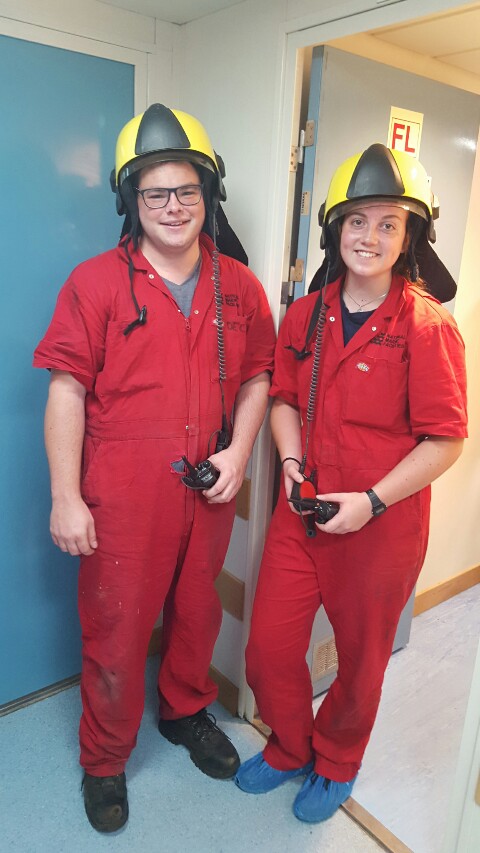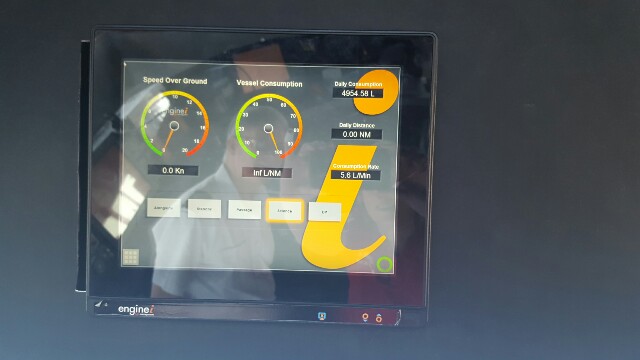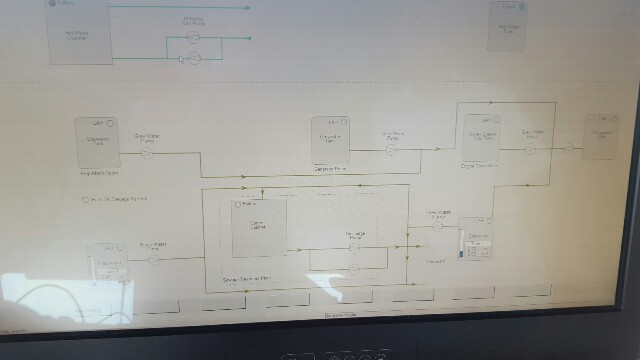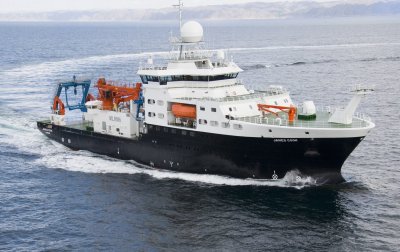Amongst other things: doors, fuel and water.
The doors on the ship are solid, made of metal, heavy and beautifully crafted. They remind me of old castles, the intricate lever mechanisms look positively medieval. You always open a door by lifting the handle (not pushing down) and you never let go. These sturdy, watertight, utilitarian, robust appliances would cause serious damage to your hands or leg if you happened to be unfortunate enough to be caught by them. The emergency fire and flood doors that operate automatically can result in death if a person was trapped by their mighty force. Many of the internal doors are normal doors – for example the cabin doors.
Watertight doors: beautifully crafted and lethal for the shins
Clockwise: cabin door, gate to the bridge, handrail – the latter two are made of finely finished brushed stainless steel.
Internal flood doors – stay out of the way!
There are two trainee cadets on the RRS James Cook. The picture below is of Christina (this is her first time at sea) and Declan. Declan has been here for a number of years. Today, Declan was showing Christina how test safety helmets. I will be speaking to them for my people profiles in the next few weeks.
Declan and Christina

The airguns started today. I’ll tell you about the airguns tomorrow. Currently we have a large bang that reverberates through the ship every 60 seconds (sometimes followed 4.5 seconds by an echo from the seabed on the hull) and will continue to do so day and night for 5 days.
The air is in the orange cable. 206 decibels is released with every blast.

Answers to Questions:
Any idea as to the cause of asymmetrical spreading?
Two things:
- Lower melt impact into the crust (around 50% of that required to fill the gap between spreading plates) which in models predisposes to the creation of detachments and asymmetric spreading.
- Low melt will form thinner crust, making it easier for seawater to reach mantle peridotite, react with it to form serpentine and thus lubricate the fault to keep it slipping again leading to a detachment fault.
Are Ocean Core Complexes a common feature of all Mid Oceanic Ridges or just slow spreading ones?
So far as we know, mainly slow (or ultra-slow) spreading ridges. None are known on fast spreading ridges though one occurs in the mid to fast back-arc basin in the Philippine Sea.
Are you hoping to image the position of magma chambers or will that be the focus of another expedition?
It is possible on this trip but is not the main focus of our expedition.
Interesting beasties?
We are highly unlikely to see any large mammals. Only maybe as we go into port. I have seen flying fish and others have seen tiny squid. Very hard to photograph either though.
How much fuel will be have used by the end of the cruise?
Today we are using 5.6 litres of fuel per minute as we are towing the airgun array. This equates to 4950 litres per day. We are travelling at 4.9 knots but probably lose ¾ of a knot due to the drag from the airguns.
Our daily fuel consumption in metric tonnes from Cape Verde is as follows: 19.6 + 3.4 + 13.1 + 15.0 + 13.7 +9.0 + 8.8 + 4.1 = 86.7 metric tonnes so far.
So quite a bit of fuel!

What about fresh water, is it kept in tanks?
The water was topped up in Cape Verde – in tanks on board. We also have our own desalination plant which tops up these water tanks from seawater.
Greywater (from showers) and blackwater (from toilets) is cleaned, there is a sewage plant on board, and then deposited in the sea.
No water on board is recycled.
Schematic diagram of water tanks.

Schematic diagram of used water
I attach the diagrams for all my geeky engineering friends (and husband).
Can I recommend any geological novels?
I put this one out to Twitter and Waterstones suggested:
Novels of James A Mitchener
Other suggestion include:
A trilogy about living on Mars. I think the first one is Red Mars. Prof Roger Searle enjoys these.
Pompeii – I think by R Harris??? This is an excellent account of a volcanic eruption.
Remarkable Creatures by Tracy Chevalier (about Mary Anning – Lyme Regis)
In Suspect Terrain by John McPhee
The Martian is also an excellent book but I cannot remember the author.
Thank you to all those who gave suggestions:
Including Geological Outreach: Plate Expectations …….. oooooo CORNY!!
Thank you to Christine Falder and Dr Rebecca Gould from Greenhead College for the questions.
We like lots of questions
Cheers
Angela














Love the photos from around the ship and thanks for the book recommendations, they are very helpful. I have read Pompeii and the Martian, both were excellent. I will try the one about Mary Anning next.
Do you know of any layman’s guides to Plate Tectonics? Something relatively easy to understand? The book group would like to learn more about this aspect of geology. If none come to mind then maybe you should write Plate Expectations yourself – it could be a best seller!!!
Thanks again, Christine
LikeLike
Lol!! Guides to plate tectonics? Not a text book? There is a book called geology for dummies which is excellent. Also the geolsoc.org.uk has great section on plate tectonics. Not too high pitched. As for a novel. ..I’ve not read any. I’ll keep asking. A
LikeLike
Theory of the Earth
James Hutton that true son of fire who said
to Burns “Aye, man, the rocks melt wi the sun”
was sure the age of reason’s time was done:
What but imagination could have read
granite boulders back to their molten roots?
And how far back was back, and how far on
would basalt still be basalt, iron iron?
Would second seas re-drown the fossil brutes?
“We no vestigae of a beginning,
no prospect of an end.” They died almost
together, poet and geologist,
and lie in wait for hilltop bouys to ring,
or aw the seas gang dry and Scotland’s coast
dissolve in crinkled sand and pungent mist.
Edwin Morgan – from Sonnets from Scotland (1984)
Having taken some time to ponder your question Angela it would seem that there are no novels written specifically about Plate Tectonic paradigm. But there is a general pattern that can be seen in works of fiction and nonfiction that make use of geological ideas:
1. Poets make the best use of geology and are not afraid to shrink back from engaging with geological ideas and terms (several of Edwin Morgan’s sonnets follow geological themes). I would recommend “Map” edited by Michael McKimm – poems after William Smith’s geological map of 1815, although you will find that “Continental Drift” is a popular title for poems and collections of poetry (eg Nancy Gaffield 2014).
2. Novelists like some of our geological jargon, or the tools of the trade (Clive Cussler was popular read with technicians when I worked on seismic boats) but often they are no more than motifs or a quite generic gloss. Some like James Mitchner’s airport novels spend some time on the geology (Alaska, Hawaii, …) while other more literary writers have little discernible earth science content (Continental Drift by Russell Banks, Lost Geography by Charlotte Bacon). In Romantic fiction, or cowboy/adventure fiction, “geologist” is shorthand for sensitive principled hunk; while this is of a course completely true depiction (and there will be no requirement for the signing of an contractual obligations) neither the romances of Claire Harrison nor the adventures of Hammond Innes have much time for real geology: as a point of interest the human eye can only distinguish c34 shades of gray hence the USGC color chart). Icelandic fiction does better than most and frequently explores issues beyond a mere motif (Nobel laureate Halldór Laxness novel Kristnihald undir Jökli/Under the Glacier). Tracy Chevalier historical novel Remarkable Creatures is a stand out example of how it could be done, Michael Crichton’s Jurassic Park shows how to take liberties with the science but is a rollicking read. Sarah Andrews is an example of a geologist who writes thrillers (Fault line 2002) but there is also the Icelandic crime writer and civil engineer Yrsa Sigurðardóttir who gets her earth science correct too.
3. Biographies of people and events have grown in popularity in recent years, “The Map that Changed the World” by Simon Winchester , “Island on Fire” by Alexandra Witze & Jeff Kanipe and “Revolutions in the Earth: James Hutton and the True Age of the World” by Stephen Baxter would be recent examples: they tend towards a popular science approach which may satisfy the general reader but can be infuriating to those with some geology as they ignore the real substance of the scientific debate or present it in an oversimplified way that does not give a balanced picture. My favourite would be “Hugh Miller: Stonemason, Geologist, Writer” by Michael Taylor, Miller was the popular science writer of his age and his work on the Old Red Sandstone was revolutionary for its time, however his evangelical beliefs do not fit with our popular mythical origins of modern geology.
4. Travelogues do, I think, give the most balanced understanding of what geologists believe and how geologists work. Hugh Miller in The Old Red Sandstone (1841) and The Cruise of the Betsy (1857) is a man of his age but still hard to better. John McPhee is a literary writer who has written a number of books in the company of geologists; if you want to know the geology his “Coming into the Country” knocks James Mitchner’s “Alaska” out of the ballpark/cricket ground. He wrote a series of five travelogues between 1981 and 1998 on the geological history of the North American continent, finally they were published in a compendium called “Annals of the Former World” which is a stunning book that will get you inside the minds of the various academic and commercial geologists that McPhee worked with, he has been called the pioneer of creative nonfiction and certainly does it better than any writer that I know.
5. Popular Science, so much to choose from, but the best are where the writer has a scientific background, Stephen J Gould, Richard Fortey, Bill McGuire and a host of others.
LikeLike
The principled hunky Geologist – of course this ship is full of them. I love the poem. Thank you. Thanks also for the suggestions. I’ll pass them on. Cheers Ax
LikeLike
Can you see the reply that Chae has written regarding suggested reading. Lovely poem. Ax
LikeLike
Thanks for answering my questions about MORs. I have always been fascinated by them since studying for my own geology A level – in fact all vivid memories I have of exam questions have involved MORs! I’m sure there will be more questions in the future and I will be passing the science onto my own A level students.
LikeLike
Pleasure to answer your Qs. I’m learning so oooo much. My mind if full of airguns atm.
LikeLike
Whats the coversion factor between fuel consumption litre per minute and tonnes
LikeLike
I’ll ask and get back to you
LikeLike
1 litre of fuel weighs about 860kilos. So boat drinks about 4.8 kilos per minute.
LikeLike
Thanks my quick investigations indicated diesel density ranges from 820 to 950g per litre. I supose differnt grades for diferent engines. With 835 being used in car engines
LikeLike
We use agricultural grade diesel and then clean it before use. Specific gravity of 0.845.
LikeLike